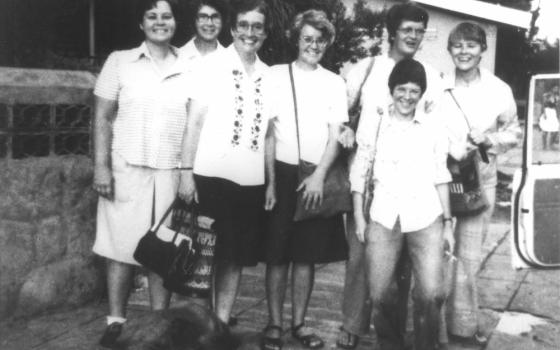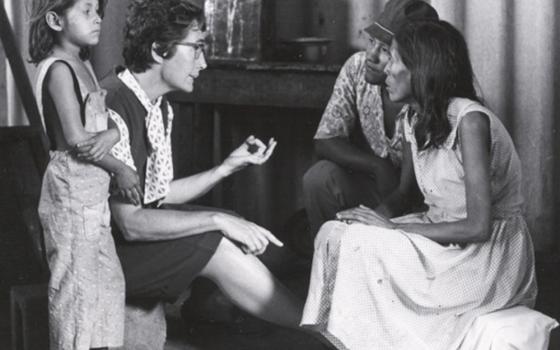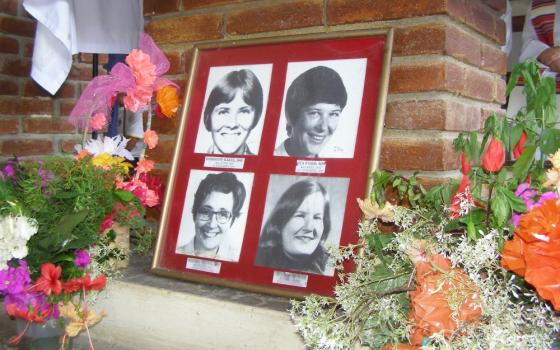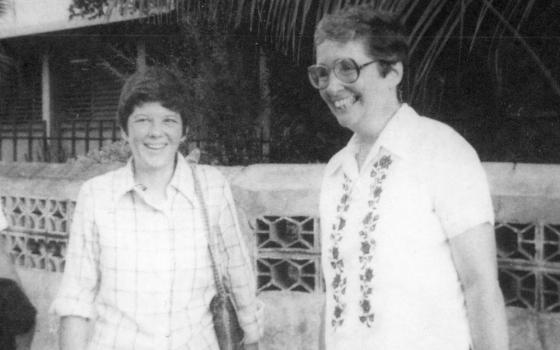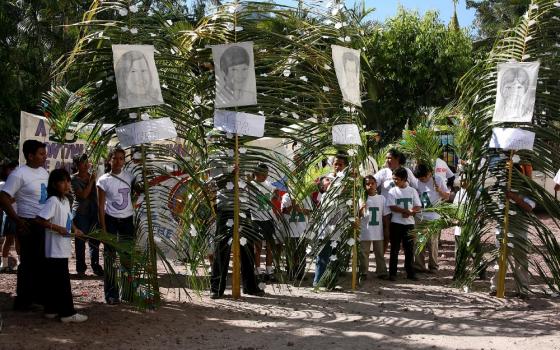Judy Ress won't forget Maryknoll Sr. Ita Ford.*
After Archbishop Oscar Romero was killed in El Salvador by Salvadoran death squads suspected of ties with the government in March 1980, Ress and Ford saw one another at a Mass in Santiago, Chile, celebrating his life.
"I asked her, 'Are you still going to go?' " said Ress, 70, a retired Maryknoll lay missionary in Santiago, as she recalled asking Ford of her plans to work in El Salvador.
"Of course," Ford told her.
Nine months later, members of the National Guard of El Salvador abducted, raped and executed four American churchwomen: Ford, 40, and Maryknoll Sr. Maura Clark, 49, from New York; Sr. Dorothy Kazel, 40, an Ursuline from Cleveland; and Jean Donovan, 27, a lay missionary who was engaged to be married, also from Cleveland.
El Salvador, Nicaragua and Central America in general in 1980 were on the frontlines of American foreign policy, part of a $7 billion Cold War-era effort to prevent left-wing guerrilla leaders from coming to power. As many as 75,000 people died and an estimated 8,000 disappeared in El Salvador, mostly at the hands of right-wing death squads and the military. The murders of the four American women jolted the American public and led to a strong domestic policy debate about the efficacy of the U.S. government's supporting and training the security forces of repressive Central American regimes.
Now, 35 years later, commemorations for the women will be held on the anniversary of their deaths Dec. 2, highlighting their service and their legacy.
"The deaths of these women have deeply marked my own life," Ress said from her home in Santiago.
She recalled Ford as a "beautiful woman, dedicated." Ford, she said, was "very intense and really tiny. She smoked. She was terribly committed. I have tried to honor their memory in different ways throughout my life."
The Leadership Conference of Women Religious and the SHARE El Salvador foundation will lead a delegation of 117 men and women to El Salvador Nov. 28-Dec. 5 to celebrate the lives of the four women. The organizations have been working with the government of El Salvador to declare the spot where the women were killed an historical site. The delegation will also be joining Salvadorans on Dec. 2 in honor of the churchwomen.
"The theme of the celebration is: 'Remembering our sisters, carrying their legacy forward,'" Jose Artiga, executive director of the SHARE foundation, said in an email. "We want to remember them alive in the struggle of women today — women running for office, women in college, women organizing in the community, women producing food and women defending their human and civil rights."
Although some church leaders worry that the decades that have passed since the murder of the women may make them more of a history lesson to later generations of Catholics than anything else, it was their very "ordinariness" that will keep their memory alive, said Eileen Markey, author of A Dangerous Woman, a biography of Maura Clarke that will be released next fall by Nation Books.
"What I find about the four of them is that they weren't special," Markey said. "They were regular people who made a series of decisions that led them to [El Salvador]. Why stay? The strange thing would have been if they left. Everything they did led them to work with the people. It would have been much more of a break in their character if they had left."
The churchwomen's work with peasant farmers in impoverished rural areas was tantamount to being subversive and a threat to the government. On the evening of Dec. 2, 1980, Clarke and Ford had returned from a conference in Nicaragua and were met at the San Salvador International Airport by Donovan and Kazel. Soldiers from the Salvadoran National Guard, part of the military, stopped their van at a military checkpoint just after they left the airport.
Peasants discovered their bodies the next day near a remote road and buried them in a common grave. About 20 miles away, burned and gutted, stood the remains of the van they had been driving. A 1993 United Nations Truth Commission report determined that Col. Carlos Eugenio Vides Casanova, the director of the National Guard in 1980, and Gen. Jose Guillermo Garcia, the Minister of Defense at the time, had coordinated an official cover-up of the murders by suggesting that robbery was the motive.
The U.S. State Department and Federal Bureau of Investigation agents eventually acknowledged evidence suggesting military involvement.
The Reagan administration also discounted the killings as the result of rogue security forces so as not to risk congressional funding of aid to El Salvador.
"In the U.S. when this happened in 1980, it was a huge moment in the U.S.," Markey said. "Their deaths highlighted U.S. policy. It got a lot of people not engaged asking what we were doing."
Today, Salvadorans continue to celebrate the lives of the four churchwomen almost as much as they do the life of Romero. But some there and in the States worry that the women's deaths as Americans overshadow the thousands of Salvadorans killed by the same security forces.
"We have to look at this well-known case in the larger context of all those who died, all that happened," said Oscar Chacon, executive director of the Chicago-based advocacy organization Alianza Americas. "There is some level of unofficial acknowledgement, but it is not enough. If people don't know, they don't know to ask."
The church also has to do some self-examination, Chacon said, because the hierarchy of the church was not entirely opposed to the right wing Salvadoran government at the time.
“The Catholic church has never been forward on any of these issues,” Chacon said. “The hierarchy [in the Vatican] was by no means of the same opinion of what was going on as the four women were. As we go forward, in the hierarchy's point of view, there is some degree of reference but no enthusiasm for a commemoration."
Much has changed in El Salvador since 1980. The Farabundo Martí National Liberation Front, or FMLN, the political party of leftist guerrillas at the time, captured the presidency in 2009. FMLN works uneasily if at all with the right-wing Nationalist Republican Alliance, known as ARENA and supported by the business elite and some elements of the military, as ARENA was when it was in power in 1980.
"For a variety of reasons, nothing like what happened in 1980 would be possible today," said Mona Lyne, professor of political science at the University of Missouri-Kansas City. "Everyone would know about it immediately with social media, unlike then. We don't see governments violate human rights so blatantly."
But violence, while no longer state-sanctioned, continues to tear El Salvador apart and leave thousands dead every year. Since 2012, when a gang truce ended, the violence has only worsened, with an average of one person killed per hour, overtaking Honduras as having the highest homicide rate in the world, excluding war zones. In August of this year alone, 100 children were killed, 779 adults and 24 seniors.
Spikes in gang- and drug-related violence have dramatically increased the flow of migrant children from El Salvador, Guatemala, and Honduras north into Mexico and the United States.
Much of today's violence can be traced back to the civil war when young men fled the country for U.S. inner cities, got into the gang culture and then returned, often by deportation, to El Salvador, said Richard Coll, foreign policy adviser for Latin America and the Global Trade Office of International Justice and Peace, U.S. Conference of Catholic Bishops.
"In El Salvador and other parts of Central America, there were great upheavals that created an atmosphere that allowed for gangs, narco-traffickers and other detrimental activities," Coll said. "A vacuum is created that fills with other actors. It should make us pause and realize their answer to violence is more violence. It creates a larger set of problems that comes back to haunt policy makers."
Although the church today does not face the kinds of threats it confronted in the 1980s, much of its work remains the same, said Sr. Karen Donahue with the Sisters of Mercy West-Midwest Community in Omaha, Nebraska.
"El Salvador remains an impoverished country, and the church continues to attend to the needs of its poorest citizens," Donahue said. "It is discouraging it has not improved. Much of that is rooted in what happened in the 1980s. Today, the mission of the church, as it was then, is to speak out on poverty. The [four] women were doing that with the people suffering then, as we [sisters] are today."
It is this spirit of ongoing work, said Ress, the retired Maryknoll lay missionary, that she will approach the anniversary of the deaths of Kazel, Clarke, Ford and Donovan.
"Today, we're still involved with women's rights and what's happening to the planet," she said. "I think they’d be right there with all of us."
*An earlier version of this story incorrectly stated that Ress met Sr. Dorothy Kazel.
[J. Malcolm Garcia is a freelance writer and author of The Khaarijee: A Chronicle of Friendship and War in Kabul and What Wars Leave Behind: The Faceless and the Forgotten. He is a recipient of the Studs Terkel Prize for writing about the working classes and the Sigma Delta Chi Award for excellence in journalism.]
Related - US women religious look back on El Salvador martyrs, ahead to delegation to mark 35th anniversary and Roses in December: A call for an end to impunity in El Salvador
